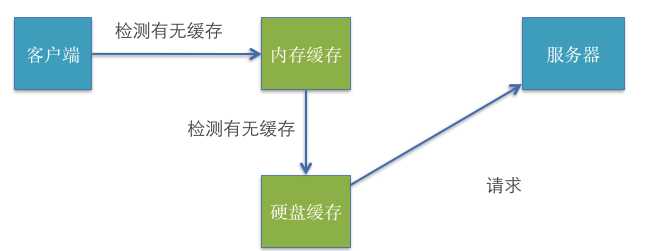标签:reserve load option toc tle 今后 disk 创建 内容
有时候,对同一个URL请求多次,返回的数据可能都是一样的,比如服务器上的某张图片,无论下载多少次,返回的数据都是一样的。

上面的情况会造成以下问题
(1)用户流量的浪费
(2)程序响应速度不够快
解决上面的问题,一般考虑对数据进行缓存。
为了提高程序的响应速度,可以考虑使用缓存(内存缓存\硬盘缓存)r

第一次请求数据时,内存缓存中没有数据,硬盘缓存中没有数据。

当服务器返回数据时,需要做以下步骤 (1)使用服务器的数据(比如解析、显示) (2)将服务器的数据缓存到硬盘(沙盒) 此时缓存的情况是:内存缓存中有数据,硬盘缓存中有数据。
再次请求数据分为两种情况:
(1)如果程序并没有被关闭,一直在运行
请求数据-> 内存数据
(2)如果程序重新启动
请求数据->硬盘数据-> 再次请求数据-> 内存数据
提示:数据从硬盘读入内存-> 程序开启-> 内存中一直有数据
由于GET请求一般用来查询数据
POST请求一般是发大量数据给服务器处理(变动性比较大)
=>因此一般只对GET请求进行缓存,而不对POST请求进行缓存
在iOS中,可以使用NSURLCache类缓存数据
iOS 5之前:只支持内存缓存。从iOS 5开始:同时支持内存缓存和硬盘缓存iOS中得缓存技术用到了NSURLCache类。
缓存原理:一个NSURLRequest对应一个NSCachedURLResponse
缓存技术:把缓存的数据都保存到数据库中。
NSURLCache *cache = [NSURLCache sharedURLCache]; - (void)setMemoryCapacity:(NSUInteger)memoryCapacity;- (void)setDiskCapacity:(NSUInteger)diskCapacity; 沙盒/Library/Caches- (NSCachedURLResponse *)cachedResponseForRequest:(NSURLRequest *)request; - (void)removeCachedResponseForRequest:(NSURLRequest *)request;- (void)removeAllCachedResponses;要想对某个GET请求进行数据缓存,非常简单
NSMutableURLRequest *request = [NSMutableURLRequest requestWithURL:url];
// 设置缓存策略
request.cachePolicy = NSURLRequestReturnCacheDataElseLoad;只要设置了缓存策略,系统会自动利用NSURLCache进行数据缓存
NSURLRequestUseProtocolCachePolicy // 默认的缓存策略(取决于协议)
NSURLRequestReloadIgnoringLocalCacheData // 忽略缓存,重新请求
NSURLRequestReturnCacheDataElseLoad// 有缓存就用缓存,没有缓存就重新请求
NSURLRequestReturnCacheDataDontLoad// 有缓存就用缓存,没有缓存就不发请求,当做请求出错处理(用于离线模式)
NSURLRequestReloadIgnoringLocalAndRemoteCacheData // 未实现
NSURLRequestReloadRevalidatingCacheData // 未实现
NSURLRequestReloadIgnoringLocalAndRemoteCacheData // 未实现缓存的设置需要根据具体的情况考虑,如果请求某个URL的返回数据:
(1)经常更新:不能用缓存!比如股票、彩票数据
(2)一成不变:果断用缓存
(3)偶尔更新:可以定期更改缓存策略 或者 清除缓存
提示:如果大量使用缓存,会越积越大,建议定期清除缓存
//
// AppDelegate.m
// A-get缓存请求
//
// Created by Mr.Sunday on 15/4/27.
// Copyright (c) 2015年 Novogene. All rights reserved.
//
#import "AppDelegate.h"
@interface AppDelegate ()
@end
@implementation AppDelegate
- (BOOL)application:(UIApplication *)application didFinishLaunchingWithOptions:(NSDictionary *)launchOptions
{
/*===============设置网络缓存==============*/
/**
内存缓存->4M
磁盘缓存->20M
diskPath 如果是 nil,会缓存到 cached 的 bundleId 目录下
只要在 AppDelegate 中加入以下两句话,今后所有的缓存处理,就不需要管了!
*/
NSURLCache *cathe = [[NSURLCache alloc] initWithMemoryCapacity:4*1024*1024 diskCapacity:20*1024*1024 diskPath:nil];
[NSURLCache setSharedURLCache:cathe];
/**
SDWebImage 的缓存
1. 缓存时间:1周
2. 处理缓存文件,监听系统退出到后台的事件
- 遍历缓存文件夹,删除所有过期的文件
- 继续遍历缓存文件夹,将最大的文件删除,一直删除到缓存文件的大小和指定的“磁盘限额”一致,停止
*/
return YES;
}
//
// ViewController.m
// A-get缓存请求
//
// Created by Mr.Sunday on 15/4/27.
// Copyright (c) 2015年 Novogene. All rights reserved.
//
#import "ViewController.h"
@interface ViewController ()
@property (nonatomic, weak) IBOutlet UIImageView *iconView;
//服务器返回的etag
@property (nonatomic, copy) NSString *etag;
//清楚所有缓存
- (void)removeAllCachedResponses;
@end
@implementation ViewController
- (void)viewDidLoad
{
[super viewDidLoad];
}
/**
1. 请求的缓存策略使用 >NSURLRequestReloadIgnoringCacheData<,忽略本地缓存
2. 服务器响应结束后,要记录 Etag,服务器内容和本地缓存对比是否变化的重要依据!
3. 在发送请求时,设置 If-None-Match,并且传入 etag
4. 连接结束后,要判断响应头的状态码,如果是 304,说明本地缓存内容没有发生变化
*/
/*==================从本地缓存加载数据==============*/
/*
NSCachedURLResponse *cachedResponse = [[NSURLCache sharedURLCache] cachedResponseForRequest:request];
self.iconView.image = [UIImage imageWithData:cachedResponse.data];
*/
- (void)touchesBegan:(NSSet *)touches withEvent:(UIEvent *)event
{
NSURL *url = [NSURL URLWithString:@"http://mrsunday.local/ml.png"];
NSMutableURLRequest *request = [NSMutableURLRequest requestWithURL:url cachePolicy:NSURLRequestReloadIgnoringCacheData timeoutInterval:10.0];
/**
*设置请求头->所有的请求头都是通过这种方法设置的
*如果etag length不为0,说明已经有缓存了
*/
if (self.etag.length > 0)
{
NSLog(@"设置 etag: %@", self.etag);
[request setValue:self.etag forHTTPHeaderField:@"IF-None-Match"];
}
//请求的默认方法是get(高频使用)
NSLog(@"%@",request.HTTPMethod);
/**
*Etag = "\"4a0b9-514a2d804bd40\"";
*可以在请求中增加一个 etag 跟服务器返回的 etag 进行对比
*就能够判断服务器对应的资源是否发生变化,具体更新的时间,由request自行处理
*/
[NSURLConnection sendAsynchronousRequest:request queue:[NSOperationQueue mainQueue] completionHandler:^(NSURLResponse *response, NSData *data, NSError *connectionError)
{
NSHTTPURLResponse *httpResponse = (NSHTTPURLResponse *)response;
/**
*allHeaderFields 所有相应头子端
*/
NSLog(@"%@ %@", httpResponse.allHeaderFields, httpResponse);
/**
*如果服务器的状态码是304,说明数据已经被缓存,服务器不再需要返回数据
*需要从本地缓存获取被缓存的数据
*/
if (httpResponse.statusCode == 304)
{
NSLog(@"load local database");
/**
*针对http访问的一个缓存类,提供了一个单例
*拿到被缓存的响应
*/
NSCachedURLResponse *cachedResponse = [[NSURLCache sharedURLCache] cachedResponseForRequest:request];
self.iconView.image = [UIImage imageWithData:cachedResponse.data];
return;
}
//记录etag
self.etag = httpResponse.allHeaderFields[@"etag"];
self.iconView.image = [UIImage imageWithData:data];
}];
}
//记得要清除缓存请求!
- (void)removeAllCachedResponses
{
[self removeAllCachedResponses];
}
@end标签:reserve load option toc tle 今后 disk 创建 内容
原文地址:http://www.cnblogs.com/isItOk/p/6035478.html